Modern Trade Retail Market Size
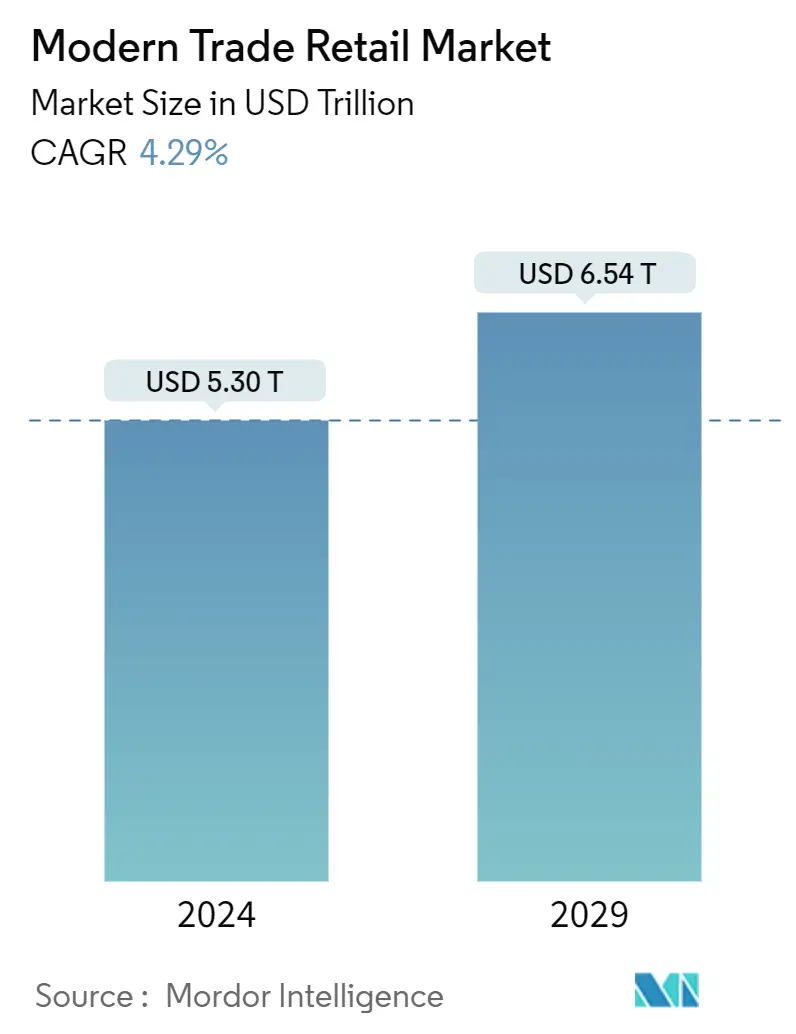
| Study Period | 2020-2029 |
| Market Size (2024) | USD 5.30 Trillion |
| Market Size (2029) | USD 6.54 Trillion |
| CAGR (2024 - 2029) | 4.29 % |
| Fastest Growing Market | Europe |
| Largest Market | Asia Pacific |
Major Players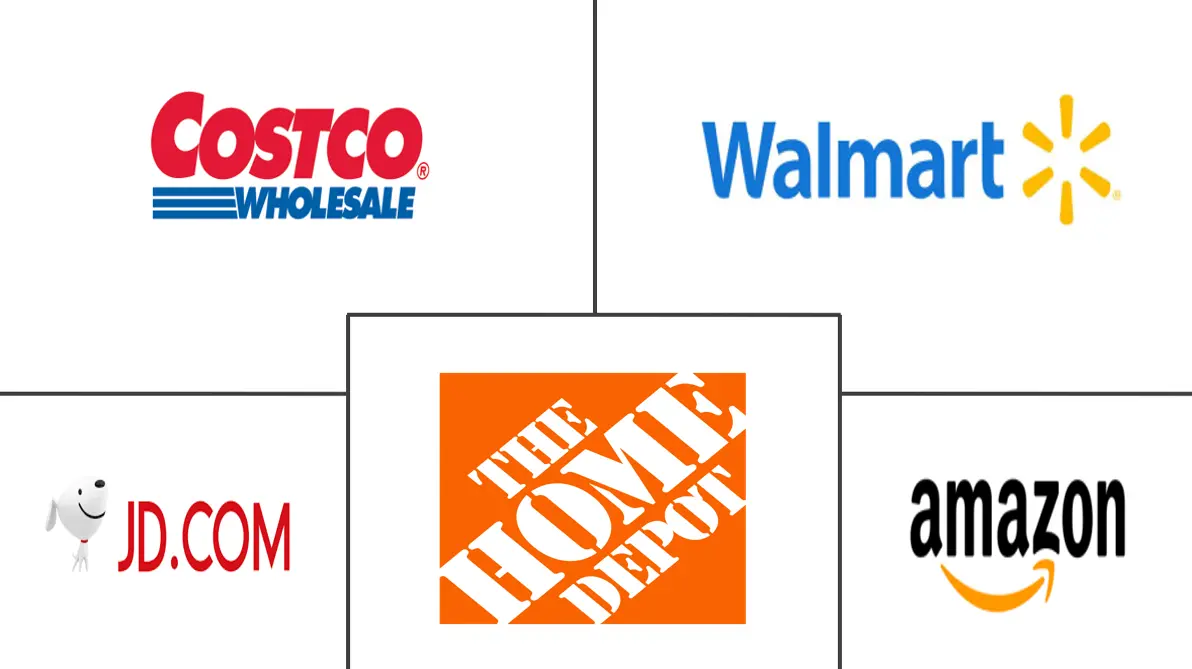
*Disclaimer: Major Players sorted in no particular order |
Modern Trade Retail Market Analysis
The Modern Trade Retail Market size is estimated at USD 5.30 trillion in 2024, and is expected to reach USD 6.54 trillion by 2029, growing at a CAGR of 4.29% during the forecast period (2024-2029).
The modern trade retail market has witnessed significant expansion, both in developed and emerging economies. Modern trade retail formats have gained popularity due to their ability to meet consumer demands effectively. Consumers appreciate the convenience, wide product selection, competitive pricing, and modern shopping experience offered by these establishments. The demand for quality products, reliable supply chains, and a one-stop shopping experience has further fueled the growth of modern trade retail.
The growth of modern trade retail has had an impact on traditional or informal retail outlets. While traditional retailers continue to serve specific niches and local communities, they face challenges in competing with the convenience, variety, and pricing offered by modern trade retail. However, a balance is maintained as both formats coexist to cater to diverse consumer needs. Several factors have contributed to the growth of the modern trade retail market. These include urbanization, rising disposable incomes, changing consumer lifestyles and preferences, increased awareness of branded products, and the convenience and variety offered by organized retail formats. The market is expected to continue evolving as retailers adapt to emerging trends and technologies to meet the ever-changing demands of consumers.
Modern Trade Retail Market Trends
Emergence of Omnichannel Retailing is Driving the Market
In the current global retail sector, omnichannel retailing is the term used to describe the blending of multiple offline and online channels to offer customers a consistent and simple purchasing experience. The main aim is to create a brand experience for customers across all platforms and touchpoints, such as physical stores, websites, mobile apps, social media accounts, and more. Customers can interact with the retailer through a variety of channels and smoothly transition between them when they shop omnichannel. Customers can purchase things via a smartphone app, explore them online, and then decide whether to have them delivered to their homes or pick them up from a physical store.
Retailers strive to deliver a consistent brand experience across all channels. This involves maintaining the same branding, promotions, price, and messaging at all touchpoints. The objective is to build a cohesive brand identity and uphold a solid rapport with clients. The focus of omnichannel retailing is to make the customer journey as smooth and convenient as possible. This involves ensuring that customers can easily navigate between channels, have access to real-time inventory information, and choose their preferred fulfillment options (e.g., home delivery, in-store pickup). Customers' expectations for a smooth and customized purchasing experience in the contemporary trade retail industry are driving the importance of omnichannel retailing. Retailers may increase revenue, foster enduring client loyalty, and improve customer happiness by implementing an omnichannel strategy.
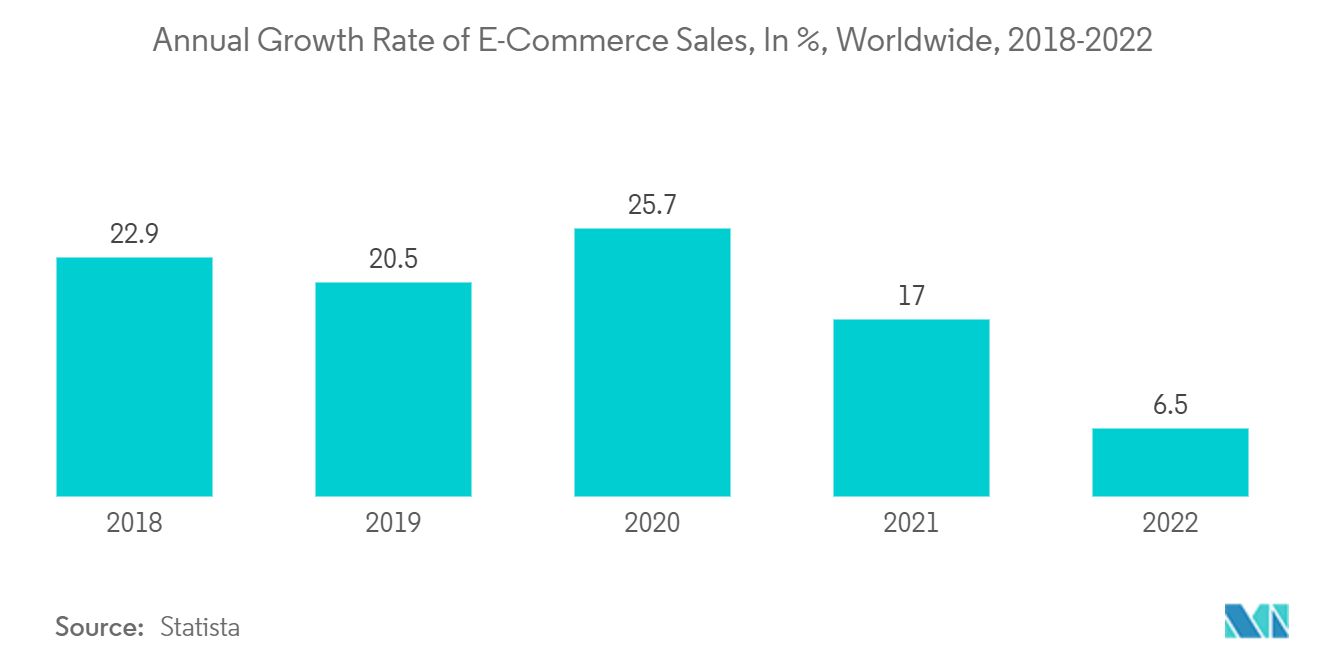
Asia-Pacific Leading the Market Driven by Increase in Disposable Income
In recent years, Asia-Pacific's modern retail trade market has grown significantly in terms of demand. Rising disposable incomes, urbanization, shifting consumer preferences, and the expansion of e-commerce are some drivers driving the market. Some of the world's fastest-growing economies, such as those of China, India, and Southeast Asia, are in Asia-Pacific. Modern retail formats, including supermarkets, hypermarkets, and specialized stores, are in more demand as consumer sophistication and income levels rise.
The rise of the modern retail trade sector in Asia-Pacific has been significantly aided by the growth of e-commerce. Customers are increasingly resorting to online shopping for convenience and a greater selection of goods as smartphones and the internet become more widely used. To meet this increasing demand, a large number of modern retail trade companies are extending their footprint in the Asia-Pacific region. For instance, Flipkart, one of the biggest e-commerce businesses in India, has had a majority investment from Walmart. Additionally, Amazon has been making significant investments in this region, growing its footprint in nations like Japan and India. Overall, rising incomes, shifting customer preferences, and the expansion of e-commerce are likely to fuel the modern retail trade market's rise in Asia-Pacific in the years to come.
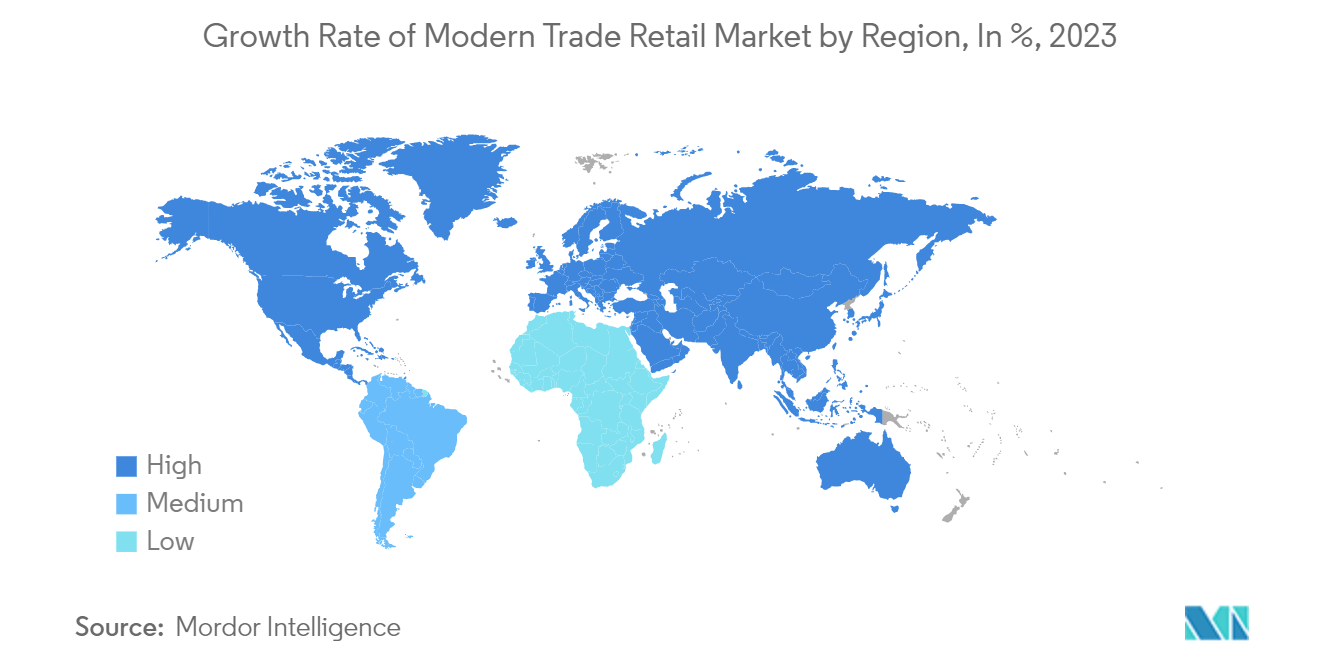
Modern Trade Retail Industry Overview
The modern trade retail market is fragmented, with various local players operating in the market. To gain a competitive advantage in the industry, the competitors are increasing their efforts to collaborate and utilize cutting-edge technology, such as AI and AR. A few of the major players in the market include Walmart Inc., Amazon Inc., Costco Wholesale Corporation, The Home Depot Inc., and JD.com.
Modern Trade Retail Market Leaders
-
Walmart Inc
-
Amazon Inc
-
The Home Depot
-
Costco Wholesale Corporation
-
JD.com
*Disclaimer: Major Players sorted in no particular order
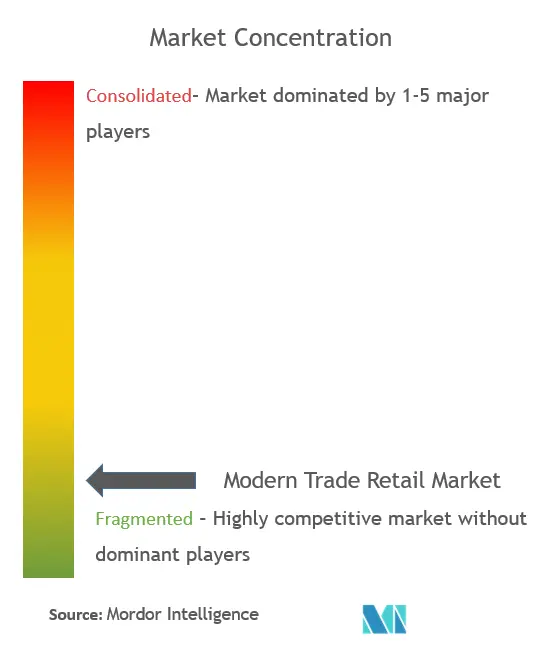
Modern Trade Retail Market News
- August 2023: Italian luxury fashion brand Gucci and Chinese e-commerce giant JD.com, popularly known as Jingdong, have partnered digitally. With the launch of a new digital flagship shop on the e-commerce retailer's platform, the partnership will reach a significant milestone.
- May 2023: Walmart announced the launch of over 28 healthcare facilities in its supercenters, providing value-based and dental care services.
Modern Trade Retail Market Report - Table of Contents
1. INTRODUCTION
- 1.1 Study Assumptions and Market Definition
- 1.2 Scope of the Study
2. RESEARCH METHODOLOGY
3. EXECUTIVE SUMMARY
4. MARKET DYNAMICS AND INSIGHTS
- 4.1 Market Overview
-
4.2 Market Drivers
- 4.2.1 Rapid Expansion of Urban Areas
- 4.2.2 Rise of E-commerce and Omnichannel Retailing
-
4.3 Market Restraints
- 4.3.1 Intense Competition in the Market
- 4.3.2 Supply Chain Complexity
-
4.4 Market Opportunities
- 4.4.1 Increasing Focus on Innovative Retail Services
- 4.4.2 Harnessing Data Analytics for Customer Engagement
- 4.5 Value Chain Analysis
-
4.6 Industry Attractiveness: Porter's Five Forces Analysis
- 4.6.1 Threat of New Entrants
- 4.6.2 Bargaining Power of Buyers
- 4.6.3 Bargaining Power of Suppliers
- 4.6.4 Threat of Substitutes
- 4.6.5 Intensity of Competitive Rivalry
- 4.7 Insights into Technological Advancements in the Industry
- 4.8 Impact of COVID-19 on the Market
5. MARKET SEGMENTATION
-
5.1 By Product Type
- 5.1.1 Food, Beverage, and Grocery
- 5.1.2 Personal and Household Care
- 5.1.3 Apparel, Footwear, and Accessories
- 5.1.4 Furniture and Home Decor
- 5.1.5 Toys, Hobby, and Household Appliances
- 5.1.6 Pharmaceuticals
-
5.2 By Ownership
- 5.2.1 Retail Chains
- 5.2.2 Independent Retailers
-
5.3 By Distribution Channel
- 5.3.1 Supermarkets/Hypermarkets
- 5.3.2 Specialty Stores
- 5.3.3 Online
- 5.3.4 Other Distribution Channels
-
5.4 By Geography
- 5.4.1 North America
- 5.4.1.1 United States
- 5.4.1.2 Canada
- 5.4.1.3 Mexico
- 5.4.1.4 Rest of North America
- 5.4.2 Europe
- 5.4.2.1 United Kingdom
- 5.4.2.2 Germany
- 5.4.2.3 France
- 5.4.2.4 Russia
- 5.4.2.5 Italy
- 5.4.2.6 Spain
- 5.4.2.7 Rest of Europe
- 5.4.3 Asia-Pacific
- 5.4.3.1 India
- 5.4.3.2 China
- 5.4.3.3 Japan
- 5.4.3.4 Australia
- 5.4.3.5 Rest of Asia-Pacific
- 5.4.4 South America
- 5.4.4.1 Brazil
- 5.4.4.2 Argentina
- 5.4.4.3 Rest of South America
- 5.4.5 Middle East and Africa
- 5.4.5.1 United Arab Emirates
- 5.4.5.2 South Africa
- 5.4.5.3 Rest of Middle East and Africa
6. COMPETITIVE LANDSCAPE
- 6.1 Market Concentration Overview
-
6.2 Company Profiles
- 6.2.1 Walmart Inc.
- 6.2.2 Amazon Inc.
- 6.2.3 Costco Wholesale Corporation
- 6.2.4 The Home Depot Inc.
- 6.2.5 JD.com Inc.
- 6.2.6 The Kroger Co.
- 6.2.7 Walgreens Boots Alliance Inc.
- 6.2.8 Alibaba Group Holding Limited
- 6.2.9 Target Corporation
- 6.2.10 Lowe's Companies Inc.*
- *List Not Exhaustive
7. MARKET OPPORTUNTIES AND FUTURE TRENDS
8. DISCLAIMER AND ABOUT US
** Subject To AvailablityModern Trade Retail Industry Segmentation
The modern trade retail market refers to the segment of the retail industry that includes supermarkets, hypermarkets, department stores, and other organized retail formats. The modern trade retail market is segmented by product type, ownership, distribution channel, and geography. By product type, the market is segmented into food, beverage, and grocery, personal and household care, apparel, footwear, and accessories, furniture and home décor, toys, hobby, and household appliances, and pharmaceuticals. By ownership, the market is segmented into retail chains and independent retailers. By distribution channel, the market is segmented into supermarkets/hypermarkets, specialty stores, online, and others (convenience stores and department stores). By geography, the market is segmented into North America, Europe, Asia Pacific, South America, and the Middle East and Africa. The report offers market size and forecasts for the modern trade retail market in value (USD) for all the above segments.
| By Product Type | Food, Beverage, and Grocery | |
| Personal and Household Care | ||
| Apparel, Footwear, and Accessories | ||
| Furniture and Home Decor | ||
| Toys, Hobby, and Household Appliances | ||
| Pharmaceuticals | ||
| By Ownership | Retail Chains | |
| Independent Retailers | ||
| By Distribution Channel | Supermarkets/Hypermarkets | |
| Specialty Stores | ||
| Online | ||
| Other Distribution Channels | ||
| By Geography | North America | United States |
| Canada | ||
| Mexico | ||
| Rest of North America | ||
| By Geography | Europe | United Kingdom |
| Germany | ||
| France | ||
| Russia | ||
| Italy | ||
| Spain | ||
| Rest of Europe | ||
| By Geography | Asia-Pacific | India |
| China | ||
| Japan | ||
| Australia | ||
| Rest of Asia-Pacific | ||
| By Geography | South America | Brazil |
| Argentina | ||
| Rest of South America | ||
| By Geography | Middle East and Africa | United Arab Emirates |
| South Africa | ||
| Rest of Middle East and Africa |
Modern Trade Retail Market Research FAQs
How big is the Modern Trade Retail Market?
The Modern Trade Retail Market size is expected to reach USD 5.30 trillion in 2024 and grow at a CAGR of 4.29% to reach USD 6.54 trillion by 2029.
What is the current Modern Trade Retail Market size?
In 2024, the Modern Trade Retail Market size is expected to reach USD 5.30 trillion.
Who are the key players in Modern Trade Retail Market?
Walmart Inc, Amazon Inc, The Home Depot, Costco Wholesale Corporation and JD.com are the major companies operating in the Modern Trade Retail Market.
Which is the fastest growing region in Modern Trade Retail Market?
Europe is estimated to grow at the highest CAGR over the forecast period (2024-2029).
Which region has the biggest share in Modern Trade Retail Market?
In 2024, the Asia Pacific accounts for the largest market share in Modern Trade Retail Market.
What years does this Modern Trade Retail Market cover, and what was the market size in 2023?
In 2023, the Modern Trade Retail Market size was estimated at USD 5.07 trillion. The report covers the Modern Trade Retail Market historical market size for years: 2020, 2021, 2022 and 2023. The report also forecasts the Modern Trade Retail Market size for years: 2024, 2025, 2026, 2027, 2028 and 2029.
Modern Trade Retail Industry Report
Statistics for the 2024 Modern Trade Retail market share, size and revenue growth rate, created by Mordor Intelligence™ Industry Reports. Modern Trade Retail analysis includes a market forecast outlook to for 2024 to (2024to2029 and historical overview. Get a sample of this industry analysis as a free report PDF download.



